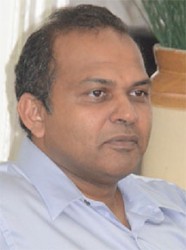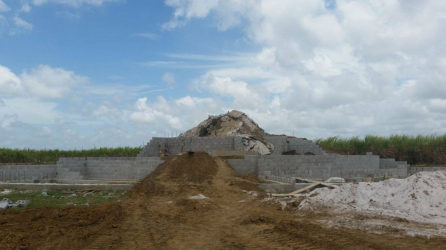A design review, including geotechnical surveys, is underway for the Indian Immigration Monument project at Palmyra, according to the government, which yesterday also reported that preliminary information suggests that a “flawed” construction method resulted in the recent collapse of the base for the structure.
The Department of Public Information (DPI) yesterday also announced that the Government of India has offered to provide technical expertise for the monument’s erection and that this will be pursued, while specialised geotechnical survey services are to be contracted.

According to the preliminary findings that were released by the DPI yesterday, a design report was not done; geotechnical surveys to determine soil properties were not done since they were not budgeted for and assumptions were made for the soil data; and the supervisory consultant that revised the project did so without adequate engineering analysis.
Further, it was noted that the monument’s base should have been constructed using a four foot wide footing, block walls were to have been infilled with structural concrete as opposed to the mortar being used at the time of collapse, and the internal base should have been 8 inches thick reinforced concrete wall and not block work infilled with mortar.
“It was infilling with mortar which was done and which subsequently failed,” the DPI statement on behalf of the government said. “Preliminary information suggests that the construction methodology used in the construction of the base of the monument was flawed which resulted in the collapse of the structure,” it added, while noting that the monument weighs 17 tonnes, making geotechnical analysis vital.
The statement suggested that the crucial lapses occurred under the former People’s Progressive Party/Civic (PPP/C) and then Minister of Culture Dr Frank Anthony, who started the project, although the former minister yesterday accused the government of changing the original design, which he believes contributed to the collapse, and attempting to score cheap political points.

The base for the US$150,000 bronze sculpture that was gifted by the Government of India crumbled in late April, while works were ongoing. It was said to be 85% completed at the time of the collapse.
Since then, the project has come under close scrutiny. While most opined that the cause of the collapse was due to substandard work being done, questions were also raised about the awarding of the $42 million contract for the construction to Linden-based company, Alternative Contracting Enterprise (ACE).
The DPI statement said yesterday Cabinet took a decision that the Ministry of Public Infrastructure would assume responsibility for oversight of the project in wake of the collapse of the base.
While no dates were given, the statement sought to outline the timeline of the project, which it said began under the former PPP/C administration.
“This project commenced under the former PPP but was stalled for several years. The coalition govnerment resuscitated the project to allow for its successful completion to honour our fore parents who came from India,” it said.
Documents Stabroek News obtained from the National Procure-ment and Tender Administration Board (NPTAB) show that the project comprised three phases.
Phase 1, which dealt with preparatory works, including construction of an access road, at the site, was awarded to Erron Lall Engineering Civil Engineering Works on September 12, 2016 at a cost of $43 million, after bids from 13 companies. The DPI statement said that to date $26.5 million was paid to the contractor and 60% of the works were completed.
Phase 2, which entailed the construction of the base, was contracted to Alternative Contracting Enterprise at a cost of $42.2 million. The contractor has been paid $22.8 million to date. And while government gave no estimation of the works completed, an employee had told this newspaper it was 85% done. It was at this stage that the structure collapsed.
Phase 3 entails landscaping and finishing works at the site. Bids were received from 11 companies and an $8.2 million contract for the works was awarded to BK International. The statement said that aspect of the works has since been suspended.
Documents have now been transferred to Ministry of Public Infrastructure and according to the statement Ministers of that ministry, David Patterson and Annette Ferguson, have held meetings with the supervisory consultants (FEBCAM), the design consultants (Innovative Engineering Consultant Services IECS) and the contractor, ACE. The ministry’s Work Services Group’s Technical team and other stakeholders were also at those meetings. Although IECS was identified as the design consultants, it was noted that it was not the initial designer of the project, which was Design Consultants Services Limited.
Seeking to cast blame
While the DPI statement pointed out that former Minister of Culture Anthony was at the helm of the sector and that his government selected the site, he rubbished the suggestion that he had to assume blame for the collapse. He said he had evidence that not only was the coalition government reluctant to continue the project but that it was solely responsible for the selection of the contractor and subsequent collapse. “While we had the preliminary designs and budget estimates, I could not proceed with the building of the monument because there was no budget in late 2014 and early 2015 because of the prorogation of Parliament. After the coalition government won, they did not allocate any budget for the construction of the monument. I asked during both budgets about the project. I specifically asked this question of the Minister within the Ministry of Education, Culture, Youth and Sport [Nicolette Henry]. And she confirmed that there wasn’t an allocation… check the Hansard, because she said that they won’t be doing anything. She was then told to remain seated while [senior minister] Dr. (Rupert) Roopnaraine answered the question. He said that the coalition will conduct a review of the project,” Anthony said.
“In the next budget, again monies were not allocated. I again raised the matter with Dr. Roopnaraine, who asked that I write him on the matter. I subsequently wrote him on the matter. Eventually the government did allocate monies to the project. However, it seems that the allocation was inadequate and not in keeping with the original costs. It also seems that someone wanted to fit the project into the new budget by reducing the scope of works at the site. The ministry should tell us who reduced the scope of the project. Was there an engineering firm? Who was responsible for supervising the contractors? Which design were they following? Can they make available a copy of the new designs? It is clear that whoever is implementing the project has made significant blunders,” he added.
The DPI statement does state that the supervisory consultant revised the project design without adequate engineering analysis but it did not indicate when this was done.
Meanwhile, Anthony informed that the Palmyra lands were donated by GuySuCo and the design for the monument was done through a competition that local artists Philbert Gajadar and Winslow Craig won. Anthony said that the monument comprises six bronze statues— replicas of four adults and two children – and amounts to “quite a few tonnes.” The engineers, he said, knew this. Therefore, he added, it should have been taken into consideration when this government amended the design.
“It is even more unfortunate that instead of owning their mistakes and rectifying it, they are seeking to put a spin on the matter and cast blame in my direction. I would not accept blame for the lame and incompetent way in which the administration has implemented this project. Nor do I agree with the changes that they have made to the original design. By changing the design they have undermined not just the engineering specifications but they have defeated the artistic intentions of having the plinth resemble the base,” he stressed.
“I think there should be an urgent investigation into this matter,” he added.
Works had ceased immediately after the collapse and the Ministry of Education asked for the help of the Ministry of Public Infrastructure to conduct an investigation to guide the way forward for the project.
But around May 10th, works started again which this newspaper reported on in its May 12th, 2017 edition. The restart of the work was queried in light of the fact that the report on the collapse had not been made public.
A worker at the site had told Stabroek News that instead of hollow blocks being used, a solid cast would be done for the structure that will hold the bronze monument. The worker, who asked not to be named, explained that while the design of the structure remains the same, “solid cast will be done.”
Workers were also observed installing steel rods and the worker said it was being done under the guidance of a new engineer. “We get a new engineer take over, Alvin Macedo, he’s from Soesdyke,” the worker said. However, when asked for a contact number for the new engineer, workers said they did not have one, since they only interacted with him when he visited Berbice to pay them.
This newspaper was then chased off the site by a man claiming to be the foreman and who said that he had spoken with the consultant and was told that no one was allowed to visit the project without permission from the company.
Works continued but then were again halted last week and no reason was given.





